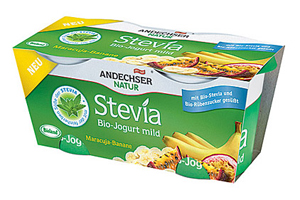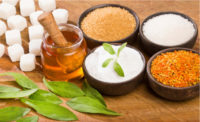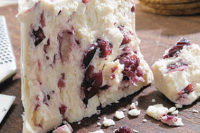
|
|
Organic yogurt from Germany’s Andechser Molkerei is sweetened with stevia. Sold in packs of two 125-gram cups, the yogurt is available in two flavors: orange and sea buckthorn, and passion fruit and banana. |
Nearly three-quarters of Americans say they are making a change regarding intake of carbohydrates, according to “2011 Food & Health Survey: Consumer Attitudes Toward Food Safety, Nutrition & Health” from the International Food Information Council, Washington, D.C. More than half say that they are trying to limit sugars. A web-based survey last year found that 56% of the 1,000 adults queried said they are trying to limit their intake of sugars. The key word here is limit, as 52% of respondents agreed that moderate amounts of sugar can be part of an overall healthful diet. This is true, as the body needs sugars, but for many, not in the amounts currently being consumed.
The American Heart Association, Dallas, recommends we consume 6 to 9 teaspoons of added sugar daily. Data show that many adults consume closer to 22 teaspoons a day, while many teenagers consume more than 30 teaspoons. It is no wonder why product developers are aggressively trying to reduce the amount of added sugars to product formulations.
There are many creative options to accomplish this. Further, according to the IFIC study, about one-third of respondents agreed that non-nutritive sweeteners, a category of alternative sweeteners, offer potential benefits for health, ranging from being a sweetening option for diabetics to playing a role in weight loss or weight management.
“Alternative sweetener” is a term that typically refers to sweeteners other than the three common monosaccharides (fructose, galactose and glucose), or sucrose (a disaccharide of glucose and fructose), all of which are often simply referred to as sugars. The list of alternative sweeteners includes ingredients obtained direct from Mother Nature (honey, for example) to chemicals produced in a lab (saccharin). Some contribute calories to a product formulation (nutritive), while others do not (non-nutritive). Some non-nutritive sweeteners actually do contain calories on a per gram basis, but because their sweetness level is so intense, usage levels are very low, resulting in virtually no contribution to a product’s caloric content.
Some alternative sweeteners are characterized by the Food and Drug Administration as artificial in the Code of Federal Regulations. Those that are not deemed artificial are often considered natural by food formulators. However, the FDA has not defined the term “natural.” Thus, characterizing a sweetener as natural is purely speculative. Many dairy product manufacturers rely on Whole Foods Market’s list of “unacceptable ingredients for food” (see www.wholefoodsmarket.com) for additional guidance on qualifying a sweetener as natural.
With consumers looking to scale back on their sugar intake, the U.S. demand for alternative sweeteners is expected to continue to grow during the next decade, according to a new “Alternative Sweetener” report from The Freedonia Group Inc., Cleveland. Gains will be led by continuing market penetration of the relatively new entrants to the industry, primarily the stevia-based sweeteners. The more mature segments of the market, such as aspartame and various polyols, will see more restrained (though still healthy) increases in demand.
Growth in ‘natural’ sweeteners
Market trends favoring less-processed ingredients will drive growth of sweeteners that can be marketed as “natural.” However, continuing consumer preference for reduced-calorie foods and beverages will ensure the ongoing use of ubiquitous sweeteners such as sucralose and acesulfame potassium (ace-k).



